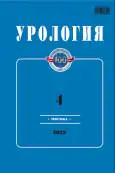Clinical experience with reusable and single – use flexible ureterorenoscopes
- Authors: Kutluev M.M.1, Grigoriev N.A.2, Safiullin R.I.3
-
Affiliations:
- Medical Center «Konsultant», Surgical Department
- AO European Medical Center, Private Educational Institution «Medical School EMC» Department of Urology
- FSBI «National Medical Research Center for Obstetrics, Gynecology and Perinatology named after academician V.I. Kulakov» of the Ministry of Healthcare of the Russian Federation, Department of Andrology and Urology
- Issue: No 4 (2023)
- Pages: 19-22
- Section: Original Articles
- Published: 21.09.2023
- URL: https://journals.eco-vector.com/1728-2985/article/view/585773
- DOI: https://doi.org/10.18565/urology.2023.4.19-22
- ID: 585773
Cite item
Abstract
Introduction. Flexible ureterorenoscopy (fURS) has become one of the most frequent procedures in urology in recent years. The main problem on the way of the spread of flexible ureterorenoscopy in everyday urological practice all over the world is the fragility of endoscopes.
Main aim. To evaluate the potential use of reusable and single-use ureterorenoscopes for kidney stones.
Materials and methods. The analysis included 30 patients who underwent of retrograde intrarenal surgery (RIRS) for kidney stones. The patients were divided into two groups. I gr. – RIRS was performed with a reusable flexible ureterorenoscope Flex XC «Karl Storz» (Germany) (n=20), II gr. – a single-use flexible ureterorenoscope PU3022 «Pusen» (China) (n=10) was used. Lithotripsy was performed with a Lumenis Pulse 100H holmium laser (Israel, USA).
Results. The age of patients, size and density of stones in I gr. and II gr. were comparable (42.5±16.9 vs 50±10.07 (years); 8.5±2.9 vs 10±2.5 (mm); 1248±315.3 vs 1376±223.3(HU+). Intraoperative complications were noted: in the I gr. - migration of stone fragments and bleeding; in the II gr. – migration of a fragment of stone. The time and efficiency of the operation of I gr. and II gr. were 75±39.9 vs 82.5±45.7 (min); 18 (90%) vs 9 (90%), respectively. Additional shock wave lithotripsy was required in 2 cases in the I gr., and more frequent usage stent was noted in the II gr. 10 (100%). In I gr. 5 (25%) patients had signs of inflammatory complication and 1 (5%) patient needed a change of antibiotics, after operation. The acute pyelonephritis was indicating in 2 (20%) patients of II gr. in the same period.
Discussion. The use of access sheath was in all patients of II gr. and in 14 (70%) cases of I gr. In 1 case of the II gr. it was not possible extract of a stone fragment from the lower calyx due to the thickness of the intrument. The possibility of bending was higher for the «Karl Storz» ureterorenoscope due to smaller diameter of the instrument. One of the disadvantages of reusable flexible ureterorenoscope is the fragility of the instrument. In our research, the repair of the instrument was required after 12 manipulations.
Conclusion. The use of smaller instruments, the use of new digital imaging, the mobility of devices, allows performing interventions simultaneously by two surgeons, achieving the greatest fragmentation or evacuation of fragments of stones with good visualization, as well as using methods of drainage-free lithotripsy («tubless»).
Full Text
About the authors
M. M. Kutluev
Medical Center «Konsultant», Surgical Department
Author for correspondence.
Email: marrat@rambler.ru
Ph.D., Urologist at the Surgical Department of Medical Center “Consultant”
Russian Federation, TulaN. A. Grigoriev
AO European Medical Center, Private Educational Institution «Medical School EMC» Department of Urology
Email: marrat@rambler.ru
Ph.D., MD, professor, Head of the Department of Urology of «Medical School of EMC»
Russian Federation, MoscowR. I. Safiullin
FSBI «National Medical Research Center for Obstetrics, Gynecology and Perinatology named after academician V.I. Kulakov» of the Ministry of Healthcare of the Russian Federation, Department of Andrology and Urology
Email: marrat@rambler.ru
Ph.D., MD, oncourologist at the Department of Andrology and Urology of National Medical Research Center of Obstetrics, Gynecology and Perinatology named after V.I. Kulakov of the Ministry of Health of Russia
Russian Federation, MoscowReferences
- Winshiper B., Lipkin M. Single-Use Flexible Ureteroscopes. In: F. Schwarz, D. Denstedt J. (eds). Ureteroscopy. Springer, Cham. 2020;73–83.
- Doizi S, Traxer O. Flexible ureteroscopy: technique, tips and tricks. Urolithiasis. 2018;46(1):47–58.
- Tekgül S., Dogan H.S., Hoebeke P., et al. EAU Guidelines on Paediatric Urology. European Association of Urology. 2016. Accessed July 2018. Available online: https://uroweb. org/wp-content/uploads/EAU-Guidelines-Paediatric-Urology-2016-1.pdf
- Collins J.W., Keeley F.X.Jr., Timoney A. Cost analysis of flexible ureterorenoscopy. BJU Int 2004; 93(7):1023–1026. doi.org/10.1111/ j.1464-410x.2003.04774.x
- Gadjev N.K., Gadjieva A.B., Mollaev R.A., Gorelov D.S., Molhasyan V.A., Mazurenko D.A., Al’-Shukri S.H., Petrov S.B. Comparison of disposable flexible ureteroscopes with flexible video and digital ureteroscopes. Eksperimental’naya i klinicheskaya urologiya. 2018;2:36–41.Russian (Гаджиев Н.К., Гаджиева А.Б., Моллаев Р.А., Горелов Д.С., Малхасян В.А., Мазуренко Д.А., Аль-Шукри С.Х., Петров С.Б. Сравнительный обзор одноразовых гибких уретеронефроскопов. Экспериментальная и клиническая урология. 2018;2:36–42).
- Emiliani E., Traxer O. Single use and disposable flexible ureteroscopes. Curr. Opin. Urol. 2017;27: 176–181.
- Lee Y.J., Bak D.J., Chung J.W. et al. Is it necessary to actively remove stone fragments during retrograde intrarenal surgery? Invest. Clin. Urol. 2016;57:274–279. doi: 10.4111/icu.2016.57.4.274.
- Grigoriev N.A. Retrograde intrarenal surgery: a modern view of the problem. Urologiia. 2018;5:175–181. Russian (Григорьев Н.А. Ретроградная интраренальная хирургия: современный взгляд на проблему. Урология. 2018;5:175–181).
- Santiago J.E., Hollander A.B., Soni S.D. et al. To Dust or Not To Dust: a Systematic Review of Ureteroscopic Laser Lithotripsy Techniques. Curr. Urol. Rep. 2017;18(4):32. doi: 10.1007/s11934-017-0677-8.
- Bach T., Geavlete B., Herrmann T.R., Gross A.J. Working tools in flexible ureterorenoscopy-influence on flow and deflection: what does matter? J. Endourol. 2008;22(8):1639–1643. doi: 10.1089/end.2008.0184.
Supplementary files








